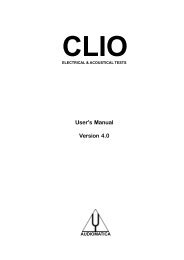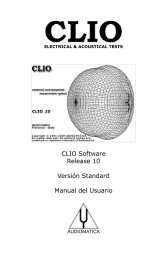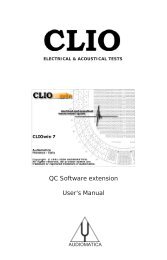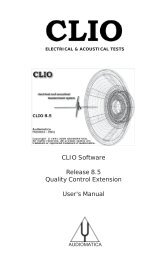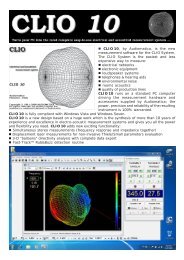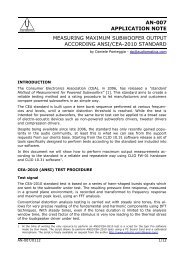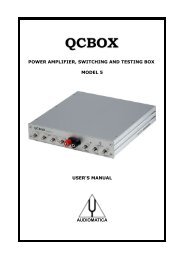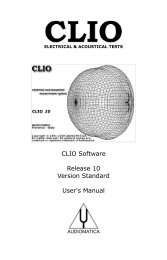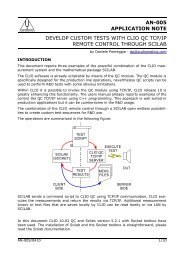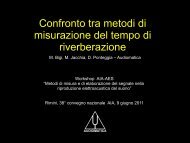CLIOwin 7 PCI User's Manual - Audiomatica
CLIOwin 7 PCI User's Manual - Audiomatica
CLIOwin 7 PCI User's Manual - Audiomatica
You also want an ePaper? Increase the reach of your titles
YUMPU automatically turns print PDFs into web optimized ePapers that Google loves.
etween the known resistor value and the marker reading at 1kHz. For example:<br />
assume a known resistor value 10 Ohm, reading at 1kHz 9.3 ohm and an I Sense value<br />
of 0.127 Ohm. Multiply 0.127 by 1.075268817 to obtain 0.13655914, input this new<br />
value and check everything by performing a new measurement.<br />
13.5 CONSTANT VOLTAGE & CONSTANT CURRENT<br />
These were the standard approaches to measuring impedance with a traditional set of<br />
instruments. We will skip further theoretical discussion and go directly on how CLIO<br />
implements them. Both these methods require two external components, a reference<br />
resistor of suitable and known value (where known means better than 1% tolerance)<br />
and a power amplifier. They also require two measurements to be taken one after the<br />
other, changing connections in between. CLIO, by means of its processing tools can<br />
speed things up a lot but the whole procedure remains quite complicated. Whatever you<br />
are going to use, MLS or Sinusoidal, all the measurements should be performed in Volts<br />
(the Y Scale should be dBV).<br />
13.5.1 CONSTANT VOLTAGE<br />
Proceeding step by step we are going to create two files, one named “reference”, the<br />
second named “device”. The two measurement files must have identical settings and<br />
identical CLIO’s output level. We choose a sensing resistor, Rs, of 1 ohm at 1%<br />
tolerance. Fig.13.11 shows connections for creating the reference file. The level you<br />
choose now is the total measuring level.<br />
CLIO<br />
INPUT A<br />
INPUT B<br />
OUTPUT A<br />
OUTPUT B<br />
RS<br />
BLACK<br />
RED<br />
POWER AMPLIFIER<br />
Figure 13.11<br />
The reference measurement is shown in Fig 13.12. As expected the output of the<br />
amplifier appears as a straight line. Should this not be so, this would not be a problem<br />
as the whole procedure compensates for any deviation in the frequency response. More<br />
interesting is the absolute level. As the Rs value is small, this level appears nearly<br />
unchanged to the speaker. We read -12dBV that translate in 250mV.<br />
Chapter 13 - Measuring impedance and T&S parameters 163



